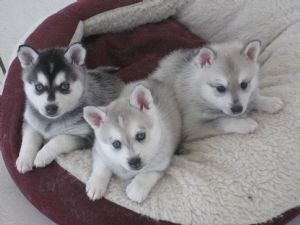The Alaskan Klee Kai is a spitz type breed of dog, developed in the 1970s to create a companion sized dog resembling the Alaskan Husky (a mixed breed of dog used for sled racing). It is an energetic, intelligent, dog with an appearance that reflects its northern heritage.
History
The breed was developed in Wasilla, Alaska, from the early 1970s to 1988 by Linda S. Spurlin and her family. The breed was developed with Siberian and Alaskan Huskies, using Schipperke and American Eskimo Dog to bring down the size without dwarfism. She bred these dogs in private until she released them to the general public in 1988. Originally called the Klee Kai, the breed split into Alaskan Klee Kai and Klee Kai for political reasons in 1995. The breed consolidated as its current name in 2002. The Alaskan Klee Kai was officially recognized by the American Rare Breed Association (ARBA) in 1995 and by the United Kennel Club (UKC) on January 1, 1997.
Appearance
Height and Weight
It is intended that the Alaskan Klee Kai remain a small to medium-sized dog. Height is measured from the withers to the ground. An Alaskan Klee Kai should not appear heavy or too thin. Weight should be proportionate to height.
Toy Variety: Up to and including 13 in (33 cm)
Miniature Variety: Over 13 in (33 cm) and up to and including 15 in (38 cm).
Standard Variety: Over 15 in (38 cm) up to and including 17 in (43 cm).
Serious Fault: Over 17 in (43 cm) up to and including 17 1⁄2 in (44 cm).
Eliminating Fault: Over 17 1⁄2 in (44 cm) in height.
Coat and coloring
Alaskan Klee Kai come in three recognized color varieties: black and white, gray and white, or red and white (which may appear as a cinnamon or a dark auburn). Solid white Alaskan Klee Kai also exist but this coat color variety is considered a disqualification by the breed standard. Solid white Alaskan Klee Kai have just recently become recognized by the United Kennel Club and may be registered but not shown competitively.
There are also two coat types found in the breed. These consist of the standard and full-coated varieties. Both are recognized by the UKC and equally acceptable by the breed standard. The only exception being that the coat length may not be so long as to obscure the outline of the dog, which is considered a breed fault. The Alaskan Klee Kai has a double coat; an undercoat that is short and soft and an outer coat that is made of longer guard hairs. This double coat allows them to have thermal protection from extreme hot and cold weather.
Like the Siberian Husky, the Alaskan Klee Kai typically requires relatively easy care. They are extremely clean. Most do not like wet feet and will spend hours daily grooming themselves. Alaskan Klee Kai, like many other northern breeds, do not have a typical "doggy odor" or "doggy breath." Most Klee Kai will seldom require a bath. They are rather efficient, so no grooming is needed. You never want to shave an Alaskan Klee Kai unless for medical reasons. They need their coat to keep them cool and to protect their skin.
Also like Siberians (and unlike short haired dogs who shed all year), the Klee Kai blows its coat twice a year. Of course, the size of the dogs limits the amount of fur blown. It is best to groom the dog on a regular basis during this time. Some of the longer haired dogs can become matted if not groomed. Most Klee Kai will assist the loss of hair by rubbing against things such as fences. Other than this period of blowing coat, the Klee Kai is very self-sufficient. The normal preventative measures should be taken, such as trimming of nails, normal grooming in the form of brushing. This process is especially important in the bonding process.
Temperament
The Alaskan Klee Kai is a highly intelligent, playful, curious and high energy breed. They love to run and should never be trusted off-leash. Unlike Siberian Huskies, whom they closely resemble, Alaskan Klee Kai can be standoffish and cautious around unfamiliar individuals. Because of their inherently reserved disposition in the presence of strangers, continual socialization throughout an Alaskan Klee Kai's life is highly encouraged. They are moderately active and have a strong prey drive. This means unless they are properly introduced and raised with smaller animals such as rabbits, hamsters, cats and birds, they will hunt them.
They can be a great family dog if raised with young children who are careful with animals: Alaskan Klee Kai are not likely to tolerate being mistreated and should be monitored when with children. Because of their intelligence, they do well in obedience classes and have a high drive to please their owners which helps them to excel in this area as well as many other types of activities. Another such activity is agility in which the Alaskan Klee Kai almost seems to have been bred to take part in.
The Alaskan Klee Kai are generally quiet dogs and are not known to be problem barkers.
Health
Previously the Alaskan Klee Kai was thought to have been remarkably free of genetic defects when compared to other small dog breeds. Current health concerns with this breed are: Thyroid Disease, Nutrition, Autoimmune Thyroditis, and FVII Deficiency.
Other health concerns that the breed may suffer from have yet to be discovered because of the breed's relatively young age and small gene pool.
Responsible Alaskan Klee Kai breeders have their dogs health tested and registered with OFA for cardiac, patellar, and thyroid issues. They are now accepted by CHIC also, if they have passed their OFA exams and eye exam by CERF.


